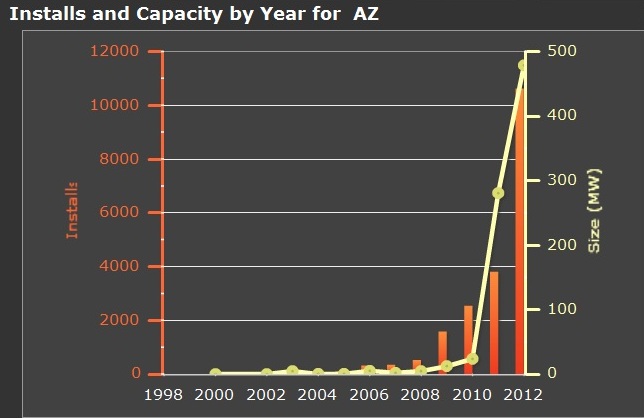Arizona, a state known for abundant sunshine and one of the fastest growing populations in the country, may be changing its rooftop solar program in a way that would decrease the benefits that utility customers receive from installing solar panels on their roofs.
What’s at stake?
Net metering is the official term for one of the most widely adopted programs designed to encourage the installation of relatively small solar photovoltaic (PV) systems on residential and commercial roofs. Specifically, net metering allows solar customers to receive credit on their electricity bills for each kilowatt-hour of electricity generated by their solar panels. A whopping 43 states plus the District of Columbia have adopted net metering policies, which has had a huge impact on the amount of people going solar across the country.
Between 2000 and 2012, solar was the second fastest growing generation resource, behind only wind. And net-metered solar is an increasing percentage of the total amount of solar power in the country. In fact, 99 percent of the solar systems installed last year were net metered, although its important to note that since utility-scale solar projects are able to generate much larger quantities of electricity, they still represent the lion’s share of solar output in the country.
To learn more about how solar power is growing in your state, check out this series of maps recently released by the National Renewable Energy Laboratory.
New proposal in Arizona could reduce solar investments
Arizona is currently second in the country when it comes to solar jobs and installed solar capacity. Yet on Monday, Arizona Public Service (APS), the state’s largest utility, filed a proposal with the state energy regulator that would reduce the amount of financial value net-metered customers receive from their solar systems.
One option in the proposal would place an additional charge on new solar customers’ bills based on the amount of electricity they consume (regardless of how much of their electricity consumption is met by generation from their own solar panels). The other option would significantly reduce the kilowatt-hour credit that new net-metered customers receive on their bill. The impact of both options would make solar more expensive for new customers. To dig into more of the details of APS’s proposal, check out the Vote Solar blog.

Graph courtesy of the National Renewable Energy Laboratory
States must find a way to adequately quantify the value of solar on the grid
Utilities across the country are feeling increasingly threatened by the idea that large numbers of their customers could go solar and reduce the amount of electricity they’d need to purchase from their local service provider. In addition to the lost revenue from lower electricity sales, utilities worry they will not be able to collect enough money to maintain the poles, wires, and other infrastructure necessary for a functioning electricity grid.
A modern, reliable, and resilient electricity grid benefits us all, and solar customers who net-meter should pay their fair share of this public resource. But any proposal to adapt utility revenue models as more people go solar must adequately consider the value that solar systems provide to the grid and a utility’s bottom line.
For example, as more customers install solar, utilities avoid capital expenditures for new power plant investments they would otherwise make to meet customers’ electricity demand. Because net-metered solar systems are installed in places where electricity is used, utilities don’t need to spend as much money moving electricity through transmission and distribution networks. This means utilities experience less line losses and can save on some of the costs to upgrade and build new transmission and distribution lines. There are also clear environmental and public health benefits to curbing fossil fuel electricity generation and replacing it with clean solar power.
Arizona is not the only state where utilities have proposed changes to residential solar programs this year. Regulators in Idaho and Louisiana turned down similar proposals to raise rates on solar customers. California has an open proceeding at the Public Utilities Commission to revise its residential rate structures (more on this in future blogs). The state is considering a rate redesign to ensure utilities recoup enough money to maintain the grid and create stronger incentives for customers to conserve electricity and make cleaner energy choices. In all these states, adequately quantifying the costs and benefits utilities receive from solar installations will be an important part of deciding whether and how rates should be restructured.
For more information on this issue, check out a recent report from the Solar Energy Power Association, which provides a nice summary of the current methods to quantify the costs and benefits of net-metered solar, and how these issues are playing out in ratemaking discussions across the country.
Solar is here to stay, so let’s figure out how to work together
There’s no question that people want cleaner energy choices. Solar system prices have dropped considerably in the past five years and installers offer a variety of financing options that are making solar investments accessible to the public. Instead of reacting defensively to the changing landscape of more customers generating their own electricity, utilities should offer solar programs that encourage clean energy investments while balancing the need to remain a viable steward of the electricity grid.
